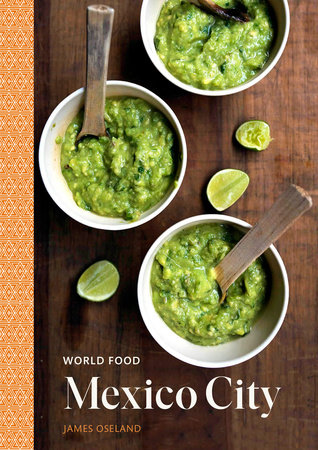Food from Hearth and HeartVictoria Hernández, a grandmother still stylish in her mid-sixties, stirs the bubbling stew with a wooden spoon and glances out the kitchen window.
Back in the village in Veracruz state, where she was raised, the morning stillness was broken by the crowing of roosters and the clopping of horses’ hooves. Here in the Mexico City neighborhood of Tepito, where she lives now, the cars are already honking, and the street teems with sellers hawking their wares. A pushcart vendor is righting a toppled stack of papayas. Under a clothesline heavy with the week’s washing, a couple of young boxers are throwing practice punches, and children have gathered to watch. The youngest girl among them spies Hernández at the window and raises her arm in greeting. She’s one of the seven people that call the three-room apartment home.
Hernández waves back at the girl, making her smile, then places a few pasilla chiles onto the hot comal, a circular grill. Since antiquity, chiles have been a fundamental component in Mexican cuisine. They are used not only as a condiment but also as a primary ingredient, and a recipe often contains more than one variety. Indeed, the meal that Hernández is making today calls for two types of dried chile: The pasilla, with its glossy, crinkled skin, contributes an earthy flavor and a mild heat to dishes. The ancho, known as a poblano when fresh, is sweeter and adds a vibrant red hue. Ground into a paste, they will fortify the
mole de olla, a rich stew made of bone-in pork and chunks of corn on the cob, zucchini, carrots, chayote, and potatoes.
Tepito has been crowded with itinerant street markets for nearly seven hundred years. The neighborhood has had a reputation for being a rough and lawless place since the Aztec era, and in that regard, little has changed. But while Hernández has lived here for five decades, she’s proud to bring the quietness and simplicity of her Veracruz upbringing to her cooking style. The chiles toasting on the comal pop and release their sharp, smoky fragrance into the air. In a blue enamel stockpot, the pork is getting tender. She places the toasted chiles into hot water to soften.
A pair of small dogs comes bursting through the door, with Flora Ayala, Hernández’s neighbor and friend, close behind. Ayala, beautiful and poised in her twenties, has come for some of her companion’s sage advice and perhaps a bit of gossip. But she knows Hernández, who has a cleaning job that starts at six every evening, still has a lot of work ahead of her, so she seats herself at the table and starts peeling vegetables for the
mole de olla.As Hernández grinds the softened chiles along with spices and fried garlic in a blender, then strains that mixture into the pork broth, the women chat. Daily life, family, politics, the conundrums of the day—this conversational aspect of meal preparation is not an exercise in biding time; it’s an integral part of the cooking process. Hernández’s teenaged granddaughter comes in to announce that there’s a new man on the block selling very convincing
fayuca—fakes, knockoffs, usually made in China—of the shoes everyone’s wearing this season. But, she adds proudly, she was not taken in by his ruse.
Hernández puts fresh green beans and chunks of
calabacitas, Mexico’s smaller, lime-green zucchini, into the pot. “Clever princess, did you remember to get tortillas?” Her granddaughter claps her hands over her mouth—oops. “I’ll do it right now,” she says, dashing for the door.
“Wait—get another avocado while you’re out. And bring your sisters in for lunch at three,” Hernández tells the girl. “Tell your grandfather, too, if you can wake him.” This last is a joke. Her husband, a parking attendant, works tirelessly, despite being in his seventies. Her granddaughter dashes out, whistling for the dogs to follow.
In her wake, Hernández’s teenaged grandson comes in. Yes, he answers Hernández before she can ask, he
has started the weekend’s homework—his mother can testify to that. Hernández pours for him an
agua fresca, cool water infused with juice or flavorings, in this case with
flor de jamaica, hibiscus blossoms. It’s a subtly sweet, sour, and refreshing drink that he gratefully gulps down.
By now the aroma is irresistible. Ayala stirs the stew, tastes it. “This is so delicious. Why is your cooking always better than food at a restaurant?”
“Because nothing tastes as good as it does at home,” Hernández replies without hesitation.
This sentiment is held in the hearts of the city’s cooks. Prepare the dishes presented in this book and you will connect to the heart of the way these people prepare food. Mexico City is inarguably famous for its street food. The dishes people make in their home kitchens, though, hold the essence of the cuisine, and are as joyfully colorful and diverse a human accomplishment as the city itself.
When you try your hand at these recipes, be patient. Cooking Mexican food is a relaxed, gradual process—true slow food. Begin, if you wish, with a simple yet essential dish like
salsa roja, to be eaten with quesadillas hot off the stove, or with
frijoles refritos, refried beans with onions and garlic. As you become more familiar with the methods and ingredients, try cooking something a bit more complex, such as
lomo adobado, pork tenderloin in a thick sauce spiked with chiles and beer. Or you might make a big pot of wholesome
mole de olla for your own family and friends. Señora Victoria Hernández would be honored if you did.
Copyright © 2020 by James Oseland. All rights reserved. No part of this excerpt may be reproduced or reprinted without permission in writing from the publisher.









